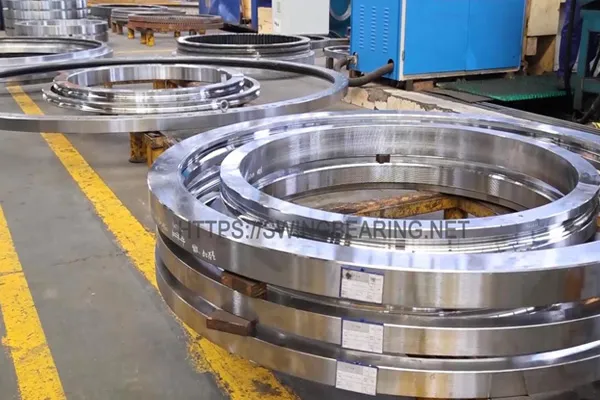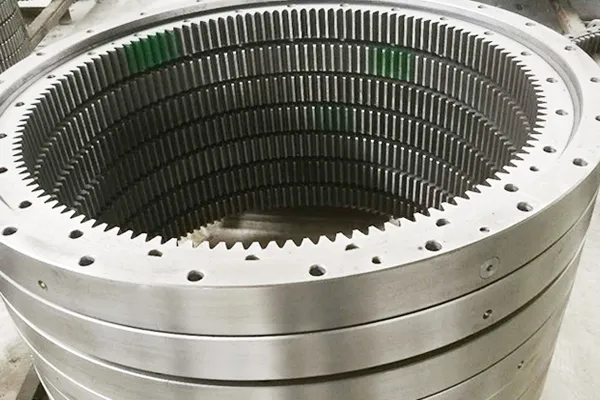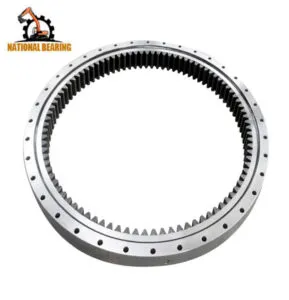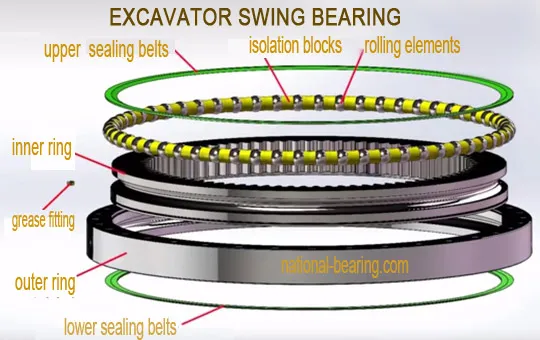
隠された力を解き明かす:掘削機の旋回リングを探す
旋回リング(スイングリング)は、スイングベアリングとも呼ばれ、掘削機の重要な部品です。掘削機の上部構造の基部に位置し、上部構造が足回りに対して回転することを可能にします。旋回リングは、上部構造の重量と掘削力を足回りに伝える役割を担っています。また、掘削機を左右に振ることもできます。

掘削機の旋回リング
について 旋回リング, a crucial component in an excavator, plays a pivotal role in enabling the machine’s upper structure to rotate smoothly upon its lower structure. Understanding its location is essential for maintenance and repair purposes.
スイングベアリングは通常、掘削機の上部構造の基部に位置し、下部構造とのインターフェースとなる。これは2つの同心リングから成り、1つは上部構造に、もう1つは下部構造に固定されています。リングは、ボールベアリングやローラーなどの一連の転動体によって分離され、回転を容易にします。
スイングベアリングの位置を特定するには、掘削機の上部構造と下部構造を確認することから始める。上部構造はキャブ、ブーム、アームを収容する部分であり、下部構造はトラックまたはホイールと足回りで構成される。
上部と下部の構造が確認できたら、それらがつながっている点を探す。これは通常、上部構造の中央にある円形または六角形の開口部である。スルーリングはこの開口部の中にある。
一部の掘削機では、旋回ベアリングの一部または全部が保護ハウジングで囲まれている場合があります。このハウジングは、スルーリングを清潔に保ち、潤滑することで、その寿命を延ばす役割を果たします。スルーリングにアクセスするには、ハウジングを取り外す必要があります。
旋回リングの位置は、特定の掘削機モデルやメーカーによって多少異なります。しかし、一般的には上部構造の基部にあり、上部構造と下部構造の間に安定した信頼性の高い接続を提供します。
スルーリングの位置を理解することは、メンテナンスと修理作業において非常に重要です。スルーリングの適切な機能を確保し、早期摩耗や故障を防ぐには、定期的な点検と注油が不可欠です。スルーリングの場所を知ることで、技術者はこれらの作業を効率的に行うことができ、掘削機の性能と寿命を最大化することができます。
スイングベアリングは、掘削機にとって重要なコンポーネントであり、上部構造の基部に位置し、下部構造と連結している。この戦略的な配置により、上部構造がスムーズかつ効率的に回転し、ショベルがさまざまな作業を行うことができる。
スルーリングは、インナーギアとアウターギアの2つの主要部品から構成されている。内歯車は上部構造物に取り付けられ、外歯車は下部構造物に固定されている。掘削機のオペレータが旋回モーターを作動させると、内歯車が回転して外歯車を駆動し、上部構造物を旋回させる。
The slew ring plays a vital role in the excavator’s functionality. It provides a stable and reliable connection between the upper and lower structures, ensuring smooth and precise rotation. Without a properly functioning スルーリング, the excavator would be unable to perform its intended tasks effectively.
上部構造の基部に旋回リングを配置することは、実用的であるだけでなく、利点でもあります。この配置により、メンテナンスや修理の際に簡単にアクセスできるようになり、ダウンタイムを最小限に抑え、掘削機の継続的な運転を保証します。
その主な機能に加えて、旋回リングは掘削機の全体的な安定性にも貢献しています。上部構造と下部構造の間に強固な接続を提供することで、掘削機の重量を均等に分散し、運転中の転倒を防ぎます。
さらに、スルーリングが上部構造の底部にあるため、油圧ラインや電気配線などの追加コンポーネントの設置が可能です。これらの部品は掘削機の運転に不可欠であり、便利なことにスルーリングを通して配線されるため、それらの保護と機能性が保証されます。
結論として、旋回リングは掘削機の重要な部品であり、上部構造の基部に位置しています。その戦略的な配置は、スムーズな回転を可能にし、安定性を提供し、重要なコンポーネントの取り付けを容易にします。旋回リングの機能と重要性を理解することは、掘削機の効率的で信頼性の高い運転を保証するために非常に重要です。
The slewing ring is a vital component in an excavator, playing a pivotal role in enabling the upper structure to rotate smoothly upon the undercarriage. Understanding its location, structure, and function is essential for troubleshooting common issues related to this critical part. This detailed guide will help you identify, diagnose, and resolve problems associated with the slewing ring, ensuring your excavator operates efficiently.
The slewing ring is typically situated at the base of the excavator’s upper structure, where it interfaces with the lower frame. It comprises two concentric rings: one fixed to the upper structure and the other to the lower frame. Between these rings are rolling elements, such as ball bearings or rollers, that facilitate the rotation of the upper structure.
To access the slewing ring, it is necessary to remove the upper structure from the undercarriage. This involves several steps:
Once the upper structure is detached, the slewing ring becomes visible as a large, circular component located at the base of the upper frame.
The primary function of the slewing ring is to facilitate the rotation of the excavator’s upper structure relative to its undercarriage. This allows the operator to maneuver the boom, arm, and bucket with precision, enhancing the excavator’s versatility and efficiency. The slewing ring must withstand significant loads and stresses during operation, making its proper maintenance and functioning critical.
One of the most common issues with the slewing ring is excessive wear. This can result from various factors, including heavy usage, inadequate lubrication, and contamination. Symptoms of excessive wear include:
To diagnose excessive wear, perform the following checks:
If excessive wear is confirmed, take the following steps:
Proper lubrication is crucial for the smooth operation and longevity of the slewing ring. Inadequate or incorrect lubrication can lead to increased friction, overheating, and premature failure.
Signs of lubrication problems include:
To resolve lubrication issues:

ショベル旋回ベアリング
Bearing failure in the slewing ring can have severe consequences, including total operational shutdown. This issue can be caused by various factors, including overloading, poor maintenance, and manufacturing defects.
Symptoms of bearing failure include:
If bearing failure is suspected:
Regular monitoring and maintenance are crucial for preventing issues with the slewing ring and ensuring its optimal performance.
Perform scheduled inspections to identify potential issues before they become severe:
Ensure that operators and maintenance personnel are adequately trained:
The slewing ring is a critical component of an excavator, enabling the upper structure to rotate smoothly upon the undercarriage. Understanding its location, structure, and function is essential for troubleshooting common issues and ensuring optimal performance. By regularly inspecting, maintaining, and addressing issues such as excessive wear, lubrication problems, and bearing failure, you can prolong the life of the slewing ring and enhance the overall efficiency and reliability of your excavator.
By following these detailed maintenance practices, you can ensure that your excavator’s hydraulic system remains in top condition, providing reliable performance and longevity. Regular monitoring, proper lubrication, and timely replacement of worn components are key to preventing common issues and maintaining the efficiency of the slewing ring.

旋回リングの構造
1.ショベルの旋回リングはどこにありますか?
- 旋回リングは掘削機の上部構造と下部構造の間にある。
2.掘削機における旋回リングの機能とは?
- 旋回リングは、掘削機の上部構造が下部構造に対して相対的に回転することを可能にする。
3.掘削機に使用されているスルーリングにはどのような種類がありますか?
- 掘削機に使用されるスルーリングには、主にボールベアリングスルーリングとローラーベアリングスルーリングの2種類があります。
旋回ベアリングとしても知られる旋回リングは、掘削機の上部構造の基部に位置する重要なコンポーネントです。これにより、上部構造が下部構造上でスムーズに回転し、掘削機が正確かつ効率的に掘削・掘削作業を行うことができます。